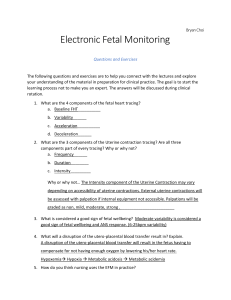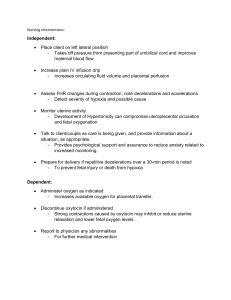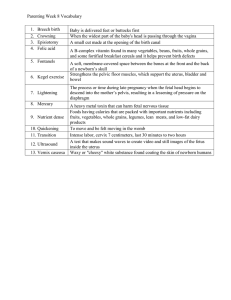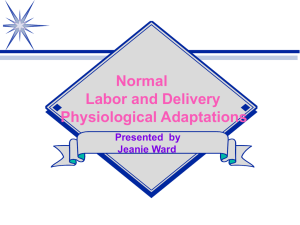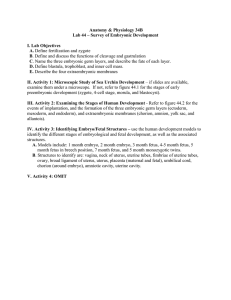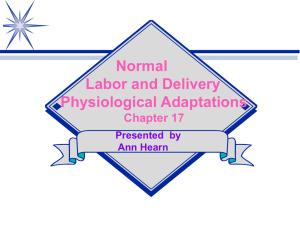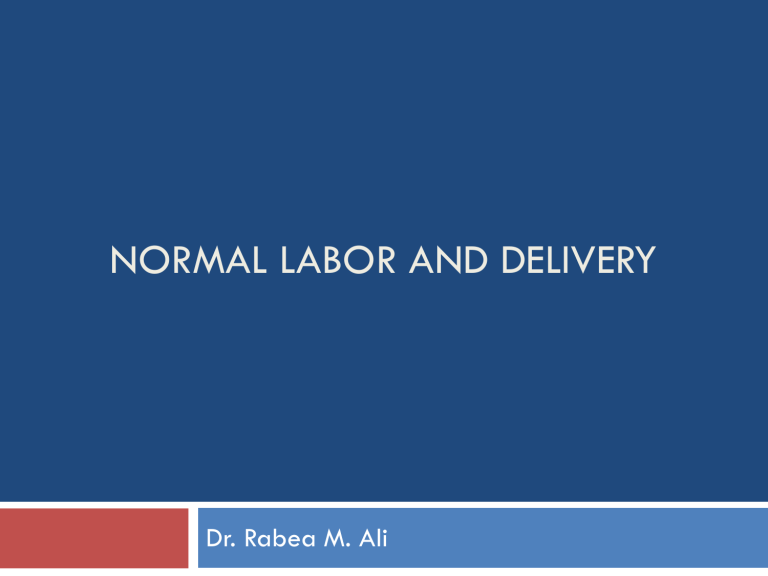
NORMAL LABOR AND DELIVERY Dr. Rabea M. Ali Definitions Labor is the process by which contractions of the gravid uterus expel the fetus. A term pregnancy delivers between 37 and 42 weeks from the last menstrual period (LMP). Preterm labor is that occurring before 37 weeks of gestational age. Definitions Postdate pregnancy occurs after 42 weeks gestation and requires careful monitoring. Termination of pregnancy before 20 weeks of gestation is defined as either spontaneous or elective abortion. Primigravida - pregnant for first time Multigravida - pregnant more than once Definition Viability - able to survive outside the womb (24+ weeks gestation) Nulliparous - never carried a pregnancy to viability Multiparous - has had two or more deliveries that were carried to viability The initiation of labor Labor is influenced by combination of factors include: - Uterine stretching - Progesterone withdrawal - increased oxytocin sensitivity - increased level of prostaglandins Theories that explain initiation of labor: Change in estrogen-to- progesterone ratio. Prostaglandin level increase in late pregnancy secondary to elevated level of estrogen. It stimulates smooth muscle contraction of the uterus: Leads to myometrium contraction Reduce cervical resistance The cervix becomes soft, thin out and dilate during labor. Theories that explain initiation of labor: Increased number of oxytocin receptors late in pregnancy, this increased the sensitivity to oxytocin as its also increased in response to estrogen rising. Oxytocin also aid in stimulation of prostaglandin synthesis in the decidua. Oxytocin effect The hormone oxytocin stimulates and enhances labor contractions. Oxytocin travels to the uterus through the bloodstream, stimulating the muscles in the uterine wall to contract stronger (increase of ideal normal value). The contractions intensity increase until the baby is outside the birth canal. When the stimulus to the pressure receptors ends, oxytocin production stops and labor contractions cease. Premonitory signs of labor Cervical changes softening and dilation with descent of the presenting part into the pelvic. This stage occurs one month to one hour before actual labor. The cervix becomes shortened and thinned segment Premonitory signs of labor Lightening: occurs when the fetal presenting part begins to descend into the maternal pelvic. The uterus lowers and moves into a more anterior position. this change will cause: Breathing becomes easier Increased pelvic pressure Cramping and low backache Lower extremities edema Increased vaginal secretion More frequent urination In PG it occurs 2 weeks ore more before labor. In MP it occurs during labor Premonitory signs of labor Increased energy level : many women will focus this energy in preparation by cleaning, cooking, preparing the nursery…it is usually occur 24-48 hours before labor. Bloody show: the mucus plug of the cervical canal during pregnancy is expelled as a result of cervical softening and increased pressure of the presenting part. The exposed cervical capillaries release a small amount of blood that mix with the mucus, resulting in bloody show. Premonitory signs of labor Braxton Hicks Contraction: these contractions aid in moving the cervix from the posterior position to the anterior position, they also help in ripining and softening of the cervix. The contractions are irregular and diminished by walking, voiding, eating, increasing fluid intake, or changing position. Premonitory signs of labor Spontaneous rupture of membrane: one in four women experience SROM before onset of labor. This reduces the capacity of the uterus, thickens the uterine wall, and increases uterine irritability. Labor usually follows. At term, 90% will be in labor within 24 h after membrane rupture. Premonitory signs of labor If labor does not begin in 24 h, the case must be considered complicated by prolonged rupture of the membranes because of the increased risk of ascending infection. Risk of cord prolapses is increased if engagement of the presenting part not occur. True versus false labor Differentiating True Labor and False Labor Factors True labor False labor Contractions timing Regular intervals, becoming close together, usually 4-6 minutes apart, lasting 30-60 seconds. Irregular intervals, not occurring close together Contraction strength Becomes stronger with time, vaginal pressure is usually felt Frequently weak, not getting strong with time Contraction discomfort Start in the back and Usually felt in the front radiates around toward of the abdomen the front of the abdomen True versus false labor Differentiating True Labor and False Labor Position changes Contractions continue no matter what positional changes is made Contraction may stop or slow down with walking or changing position Effect of analgesia Not terminated by sedation Frequently abolished by sedation Cervical change Progressive effacement and dilation No change MATERNAL SYSTEMIC RESPONSES TO LABOR CV system–cardiac output increases. Respiratory system–oxygen consumption during labor equals moderate to strenuous exercise. Renal system–with engagement, bladder pushed forward and upward. GI system–peristalsis and absorption decrease. Fluid and Electrolyte balance–body temperature increases and client perspires profusely. Immune system–white blood count increases Integumentary system–vagina and perineum have great ability to stretch. Musculoskeletal system–relaxation of pelvic joints, may result in backache. Neurological system–endorphins increase pain threshold, sedative effect. Monitor Vital Signs Every hour during early labor: Blood pressure (BP), pulse (P), and respiratory rate (R) every 30 minutes During active, transition, and the second stage of labor: to include the temperature every hour. Blood pressure, P, and R every 15 minutes While on Pitocin: The FHTs should be checked and recorded on admission Every 15 minutes during the first stage of labor Every 5 minutes during the second stage of labor, and immediately after rupture of membranes. Nursing interventions Patient Given an Opportunity to Void every 2 hours Full bladder may interfere with labor progress Patient is Nothing given orally During Labor. This cause Prolonged Gastric emptying, Vomit, and may need for C/section Ice chips only given Positioning During Labor Assist the patient in turning from side to side. Elevate the head of the bed 30 degrees; this makes it easier for the patient to breathe. Try to keep the patient off her back to prevent supine hypotensive syndrome. May result in pressure of the enlarged uterus on the vena cava, reduces blood supply to the heart, decreases blood pressure, and reduces blood circulation to the uterus and across the placenta to the fetus. The best position for the patient is on her left side since this increases fetal circulation Factors affecting the labor process: Labor entails the interaction of the so-called 5Ps: Passageway( birth canal) Passenger( fetus and placenta) Power( contractions) Position( maternal) Psychological response Passage way: It consist of maternal pelvis and soft tissue Bony pelvis: it is divided into: - False pelvis: consist of the upper flared parts of the two iliac crests - True pelvis: the bony passageway through which the fetus must travel, it made up of three planes: Passageway: 1- Pelvic inlet: allow entrance to the true pelvis. A measurement >12 cm suggests adequacy. 2- Mid pelvis: the mid pelvis (cavity) occupies the space between the inlet and outlet. 3- Outlet :The outlet is limited interiorly by the arch of the symphysis pubis, posteriorly by the tip of the coccyx, and laterally by the ischial tuberosities. fetus over bony pelvis in normal presentation for birth Pelvic shape: Anthropoid pelvis: is common in men and occurs in 20-30% of women. This pelvis is usually favorable for a vaginal delivery. Android pelvis: common in men and occurs approximately in 20% of women, it has a heart shape inlet with narrow side walls. It is called a funnel pelvis and produces a difficult vaginal delivery. Pelvic shape: Gynecoid pelvis: is less common in men and is considered the true female pelvis, although only about half of all women have this type, vaginal birth is most favorable with this type. Platypelloid or flat pelvis is the least common type of pelvic structure among men and women with incidence of 5%. Women with this pelvis require C/S. The soft tissue The cervix (effacement and dilation): Effacement: How thin is the cervix (in cm or %) The pelvic floor muscles: help the fetus to rotate anteriorly as it passes through the birth canal. The vagina: the soft tissue of the vagina expands to accommodate the fetus during birthing. Passenger a. Fetal skull: is the largest presenting part and least compressible fetal structure, making it an important factor in relation to labor and birth. Measu rement fetal head: 1. transverse diameter – 9.25cm - biparietal – largest transverse - bitemporal 8 cm 2. bimastoid 7cm smallest transverse Passenger Sutures – intermembranous spaces that allow molding. 1.) Sagittal suture – connects 2 parietal bones 2.) Coronal suture – connect parietal & frontal bone 3.) Lambdoidal suture – connects occipital & parietal bone Moldings: the overlapping of the sutures of the skull to permit passage of the head to the pelvis Passenger Fontanels: 1.) Anterior fontanel – bregma, diamond shape, 3 x 4 cm, (> 5 cm – hydrocephalus), 12 – 18 months after birth- close 2.) Posterior fontanel or lambda – triangular shape, 1 x 1 cm. closes – 2 – 3 months after birth Fetal attitude Is another important consideration related to passenger. It refers to the posturing (flexion or extension) of the joints and the relationship of fetal parts to one another. Fetal Lie The relationship of the long axis of the fetus to the long axis of the mother. The lie is longitudinal with a vertex or breech presentation or otherwise transverse or oblique, as with a shoulder presentation Fetal Presentation Presentation describes that part of the fetus that is lowest in the pelvis inlet first three main fetal presentation: the cephalic( head): 95% of the term new born the breech( pelvis):3% of term births the shoulder( scapula): 2% of term births. Fetal Presentation In cephalic presentation: the presenting part is usually the occiput portion of the fetal head. Vertex presentation is most common: the portion of the head that is covered by wearing beani cap. Brow or face presentation is a variation on vertex, but with deflexion of the fetal head, allowing the brow or face to enter the pelvis first. Fetal Presentation In a breech presentation, the fetal buttocks (the breech) are the presenting part. The breech presentation has several variations: Frank breech: the fetal legs are extended above the fetal pelvis with the breech as the presenting part Complete breech: the feet and buttocks present together Single-footling breech: one leg/foot is extended and presenting Double-footling breech: both legs/feet are extended and presenting. Although all abnormal presentations have an increased incidence of cord prolapse, footling breeches are especially at risk. A shoulder presentation implies a transverse lie. Compound presentations (e.g., vertex and an extremity together) rarely are seen with term pregnancies. The position of the presenting part is best determined by vaginal examination Fetal position: Position of the presenting part is described as the relationship between a certain landmark on the fetal presenting part and the maternal pelvis, as follows: Anterior, closest to the symphysis Posterior, closest to the coccyx Transverse, sidewall. closest to the left or right vaginal Fetal engagement: Engagement is determined by pelvic examination. It occurs two weeks before term in primigravida and several weeks before the onset of labor or not until before labor begin. Station refers to the relationship between the fetal presenting part and pelvic landmarks. Fetal engagement: When the presenting part is at zero station, it is at the level of the ischial spines, which are the landmarks for the midpelvis. This is important in the vertex presentation because it implies that the largest dimension of the fetal head, the biparietal diameter, has passed through the smallest dimension of the pelvis, the pelvic inlet. Fetal engagement: In 1988, the American College of Obstetricians and Gynecologist introduced a classification dividing the pelvis into 5-cm segments above and below the spines: If the presenting part is 1 cm above the spines, it is described as -1 station. If it is 2 cm below the spines, the station is +2. At -5 station, the presenting part is described as floating. At +5 station, the presenting part is on the perineum, and it may distend the vulva with a contraction and be visible to an observer. Cardinal movement of labor: Mechanism of labor The process of labor and delivery is marked by characteristic changes in fetal position or cardinal movements in relation to the maternal pelvis. These spontaneous adjustments are made to effect efficient passage through the pelvis as the fetus descends. Cardinal movement of labor: Engagement is the descent of the largest transverse diameter, the biparietal diameter, to a level below the pelvic inlet. An occiput below the ischial spines is engaged. Descent of the head is a discontinuous process occurring throughout labor. Because the transverse diameter of the pelvic inlet is wider than the AP diameter, and because the greatest diameter of the unflexed fetal head is the AP diameter, in most instances the fetus enters the pelvis in an occiput transverse alignment. Cardinal movement of labor: Flexion decreases the AP diameter of the fetal head. It occurs as the head encounters the levator muscle sling, thereby decreasing the diameter by approximately 1.5 to 2.5 cm (occipitomental, 12.0 cm, to occipitofrontal, 10.5 cm). Later, further flexion occurs, reducing the diameter to 9.5 cm (suboccipitobregmatic). Cardinal movement of labor: Internal rotation: occurs in the midpelvis. The architecture of the midpelvic passageway changes so that the AP diameter of the maternal pelvis at this level is greater than the transverse diameter. The fetus accommodates to this change by rotation of the head from a transverse orientation (occiput transverse) to an AP alignment (usually occiput anterior), thus accomplishing internal rotation. Further descent to the level of the perineum occurs with the head aligned in the AP plane. Cardinal movement of labor: Extension of the head allows delivery of the head from the usual occiput anterior position through the introitus. The face appears over the perineal body Occurs once fetus has descended to the level of the introitus Base of occiput in contact with inferior margin of symphysis pubis Cardinal movement of labor: External rotation occurs after delivery of the head, when the fetal head rotates back, or restitutes, toward the original transverse orientation (external rotation or restitution) when the bisacromial diameter (fetal shoulders) is aligned in an AP orientation with the greatest diameter of the pelvic outlet. Cardinal movement of labor: Expulsion: The remainder of the delivery proceeds with presentation of the anterior shoulder beneath the symphysis pubis and the posterior shoulder across the posterior fourchette Cardinal Movements of Labor Descent Flexion Internal rotation Extension External rotation Expulsion The Powers Forces generated by uterine musculature Frequency, amplitude (intensity), and duration of ctx’s Observation, manual palpation, tocodynamometry, intrauterine pressure catheter (IUPC) Contractions cause complete dilation and effacement of the cervix. Uterine contraction: Uterine contraction is involuntary and there fore cannot be controlled by the experiencing women.ut. Cont. is intermittent and rhythmic with a period of relaxation. Uterine cont.has three phases: Increment: building up of the contraction Acme: peak or highest intensity Decrement: descent or relaxation of the uterine muscle fibers The POWERS: Uterine Contractions Characteristics of Contractions Frequency: How often they occur? They are timed from the beginning of a contraction to the beginning of the next contraction. Regularity: Is the pattern rhythmic? Duration: From beginning to end - How long does each contraction last? Intensity: By palpation mild, moderate, or strong. Assessment of Contractions Palpation: Use the fingertips to palpate the fundus of the uterus Mild: Uterus can be indented with gentle pressure at peak of contraction Moderate: Uterus can be indented with firm pressure at peak of contraction (feels like chin) Strong: Uterus feels firm and cannot be indented during peak of contraction Parameters of uterine contraction: Interval 10 to 20 minutes between contractions: early labor 3 to 5 minutes between contractions: late labor Duration 20 second long contraction: early labor 40 to 80 second long contraction: late labor Quality Uterus can be dented (poor quality): early labor Uterus is hard (good quality): late labor Intra-abdominal pressure: Increased intra-abdominal pressure (voluntary muscle contraction) compresses the uterus and adds to the power of the expulsion forces of the uterine contraction. Psychological responses: The birth experience influence the woman's self confidence, self esteem, and her view of life, her relationships, and her children. Factors influencing a positive birth experience include: clear information on procedure positive support, not being alone sense of mastery, self- confidence trust in staff caring for her positive reaction to the pregnancy personal control over breathing Preparation for childbirth experience. Maternal position: Changing positions and moving around during birth offer several benefits, it facilitate fetal descend and rotation Squatting position enlarges the pelvic outlet by approximately 25% . The use of upright or lateral position compared with supine or lithotomy positions may: reduce the duration of the second stage of labor reduce the number of assisted deliveries( vacuum and forceps) Maternal position: reduce episiotomies and perineal tear contribute to fewer abnormal fetal heart increase comfort/ reduce request for pain medication enhance a sense of control reported by mothers alert the shape and size of the pelvis, which assist descent assist gravity to move the fetus downward reduce the length of labor Physiologic responses to labor: Maternal responses: Increased heart rate by 10 to 18 bpm Increased cardiac output by l 0 to 15% during the first stage of labor and increased by 30 to 50% during the second stage of labor Increased blood pressure by 10 to 30 mm Hg during uterine contractions in all labor stages Increase in white blood cell count to 25,000 to 30,000 cells/mm3 perhaps as a result of tissue trauma Increased respiratory rate along with greater oxygen consumption related to the increase in metabolism Maternal responses: Decreased gastric motility and food absorption, which may increase the risk of nausea and vomiting during the transition stage of labor Decreased gastric emptying and gastric pH which, which increase the risk of vomiting and aspiration Slight elevation in temperature possibly as a result of an increase in muscle activity. Muscular aches/cramps as a result of a stressed musculoskeletal system involved in the labor process. Increased BMR and decreased blood glucose level because of the stress of labor. Fetal responses 1. 2. 3. 4. 5. Periodic fetal heart rate accelerations and slight decelerations related to fetal movement, fundal pressure, and uterine contractions. Decrease in circulation and perfusion to the fetus secondary to uterine contractions. Increased in arterial carbon dioxide pressure(PCO2) Decrease in fetal breathing movements throughout labor. Decrease in fetal oxygen pressure with a decrease in the partial pressure of oxygen (PO2). Fetal assessment in labor External monitoring Internal monitoring Stages of labor: First stage The first stage of labor begins with the onset of labor and ends with complete (10 cm) dilatation of the cervix. Duration of the first stage: The first stage is the longest, averaging 8–12 h for primigravidas or6–8 h for multiparas. However, the first stage of labor may be markedly shorter or longer depending on the 5Ps. Labor is a very dynamic process, and contractions should increase steadily in regularity, intensity, and duration. This is not always the case, and one must set limits concerning the progress of labor. Cervical Effacement and Dilatation Cervical Effacement: the progressive shortening and thinning of the cervix during labor. 0 – 100% Cervical Dilatation: the increase in diameter of the cervical opening measured in centimeters. 0 – 10 cm. Causes of cervical dilatation Contraction and retraction of uterine musculature. Mechanical pressure by the fore bag of waters, if membranes still intact, or the presenting part, if they had ruptured. This in turn will release more prostaglandins which stimulate uterine contractions and cervical effacement. Softness of the cervix which has occurred during pregnancy facilitates dilatation and effacement of the cervix. Phases of the first stage labor: Latent phase of labor begins with the onset of regular uterine contractions and extends to the start of the active phase of cervical dilatation (_0-3 cm). Contractions may or may not be painful( mild) Cervical effacement from 0-40% Dilate very slowly Can talk or laugh through contractions May last days or longer May be treated with sedation, hydration, ambulation, rest, or pitocin Nullipara lasting up to 9 hours, multipara lasting up to 5 to 6 hours. prolonged latent phase: defined as greater than 20 hours in a nullipara and greater than 14 hours in a parous woman Phases of the first stage labor: Active phase of labor: lasts from 4 to 7 cm dilation, moderate contractions. Regular, frequent, usually painful contractions cervical dilation rate of 1.2 cm/hr for nulliparas and 1.5 cm/hr for parous women cervical effacement 40 to 80% nullipara lasting lasting up to 6 hours, multipara lasting up to 4 hours. Contraction frequency every 2 to 5 min. Contraction duration 45 to 60 seconds. Are not comfortable with talking or laughing during their contractions Phases of the first stage labor: Transition phase: is from 8 to 10cm dilation, strong uterine contraction. Cervical effacement from 80 to 100% Nullipara lasting up to 1 hour, multi Para lasting up to 30 minutes. Contraction duration 60 to 90 seconds Contraction intensity hard by palpation. CHARACTERISTICS OF THE TRANSITION PHASE Restlessness Hyperventilation Bewilderment and anger Difficulty following directions Focus on self Irritability Nausea, vomiting Very warm feeling Perspiration Increasing rectal pressure Cause of Pain in Labor First -dilatation of cervix stretching of lower uterine segment, pressure on adjacent structures muscular hypoxia Second- uterine hypoxia pressure on adjacent structures Distention of perineum and vagina Third- uterine contractions Causes of Pain in Labor Stretching of the cervix during dilation & effacement Uterine Anoxia Stage One Stretching of the uterine ligaments Causes of Pain in Labor Distention of the vagina and Perineum Stage Two Compression of the nerve ganglia in cervix & lower uterus Pressure on urethra, bladder, rectum during fetal descent Traction on and stretching of the perineum Factors affecting Mothers Response to Pain in Labor Preparation - Knowledge and confidence gained through childbirth classes Cultural influences on expression of pain Maternal fatigue, anxiety, sleep deprivation Previous experiences with pain Support Management the fist stage of labor: Ambulation OK with intact membranes If in bed, lie on one side or the other…not flat on her back Check vital signs every 4 hours (if membrane rupture or high temperature: hourly) ADMISSION PROCEDURE -One of the most critical diagnoses in obstetrics is the accurate diagnosis of labor: History Physical examination: Fundal height measurement Uterine contraction (duration, frequency, intensity) fetus (presentation, heart rate, size) fetal membrane, vaginal bleeding & leakage The fetal heart rate should be checked, especially at the end of a contraction and immediately, thereafter, to identify pathological slowing of the heart rate Pain level Laboratory studies: CBC Blood type and RH UA (pretein, glucose) Syphilis, hepatitis B, HIV Oral intake - food should be withheld during active labor and delivery - in labor & analgesics are administered :gastric emptying time is prolonged :not absorbed ,vomited, and aspiration -sips of clear liquids, occasional ice chips, and lip moisturizers are permitted Intravenous fluids -there is seldom any real need for such in the normally pregnant at least until analgesia is administered During early labor, for low risk patients, note the fetal heart rate every 1-2 hours. During active labor, evaluate the fetal heart every 30 minutes Urinary bladder function -bladder distention should be avoided : obstructed labor subsequent bladder hypotonia and infection -ambulation: self voiding, if not, intermittent catheterization NURSING CARE DURING THE FIRST STAGE OF LABOR Establish a rapport with the patient and significant others. Explain all procedures or routines, which will be carried out prior to performing them. These include: NPO except ice chips while in labor. Use of fetal monitors. Progress reports. Visitation policies. Where patient's personal belongings will be maintained. Evaluation of labor progress: Vaginal examination: -Dilatation -Effacement -Station -Position -Consistency - Fetal descent & Presenting part -Status of membranes Uterine contraction Leopold's Maneuvers Stages of labor : Second stage (2) The second stage of labor begins when the cervix becomes fully dilated and ends with the complete birth of the infant. Begins with complete dilation (10 cm) and ends with birth of the baby The second stage normally lasts up to 1 hour. While one should be concerned when the second stage extends longer than 1 h (based on fetal morbidity and mortality). Safety for the fetus may be assured by thoughtful monitoring. 2nd Stage: Birth of the Baby Begins when cervical dilatation is complete and ends with birth of the baby. Impending Signs: Bulging of the perineum. Dilatation of the anal orifice. Nausea, Irritability and uncooperativeness. Complaints of severe discomfort. Dilatation and effacement – complete – patient is instructed to push with each contraction to bring the presenting part down into the pelvis Second stage of labor Patient to rest between contractions Push with contractions One person should coach. Verbal encouragement and physical contact help reassure and encourage the patient. Monitor the patient's BP and the FHR every 5 minutes and after each contraction. The second stage of labor Pelvic phase: period of fetal descend Perineal phase: period of active pushing Nullipara lasts up to 1 hour, multipara lasts up to 30 minutes. Contraction frequency every 2 to 3 minutes or less Contraction duration 60 to 90 seconds. Strong urge to push in perineal phase. Stages of Labor and Delivery Episiotomy Surgical incision of perineum at the end of second stage of labor to:1- facilitate delivery and 2-to avoid laceration of perineum 3-Allows easier delivery Most common is midline or median incision Types of episiotomies Midline or median incision Most common Perineum are separated at anatomic junction Mediolateral Done if perineum is too small Muscles must be cut More uncomfortable Only done when necessary Second stage: delivery (continued) After delivery Airway is cleared and umbilical cord is clamped with two clamps and is severed between the clamps Nurse should remain calm and supportive to the parents Nurse should be aware that the parents may be alarmed and require support and explanations to allay their fears for the newborn Stages of labor: Third stage (3) The third, or placental, stage of labor is the period from birth of the infant to 1 h after delivery of the placenta. The rapidity of separation and means of recovery of the placenta determine the duration of the third stage Begins with delivery of infant and ends with delivery of placenta Average for both primaparas and multiparas is 5 to 20 minutes Placental Delivery Stages of labor Third stage: delivery of the placenta Placental separation signs When placenta detaches from uterine wall, a 1.sudden outpouring of blood appears from vagina 2.Cord protruding from vagina lengthens, and 3.shape fo uterus becomes more rounded and firm Practitioner repairs the episiotomy Total blood loss is from 200 to 300 mL; excessive if more than 500 mL Third stage :Delivery of placenta After delivery of the foetus, the uterus continues to contract and retract. As the placenta is inelastic, it starts to separate through the spongiosa layer by one of the following mechanisms: Schultze’s mechanism (80%) The central area of the placenta separates first and placenta is delivered like an inverted umbrella so the foetal surface appears first followed by the membranes containing small retroplacental clot. There is less blood loss and less liability for retention of fragments. Third Stage Duncan’s mechanism (20%) The lower edge of the placenta separates first and placenta is delivered side ways. There is more liability of bleeding and retained fragments. The 3rd stage is composed of 3 phases: Placental separation. Placental descent. Placental expulsion. Nursing Care 3rd stage Following delivery of the placenta: Observation of the fundus. Retention of the tissues in the uterus can lead to uterine atony and cause hemorrhage. Massaging the fundus gently will ensure that it remains contracted. Allow the mother to bond with the infant. Show the infant to the mother and allow her to hold the infant Stages of labor Third stage: delivery of the placenta Common for oxytotic medications, Pitocin or Methergine, administered during this stage Accelerates childbirth and prevents blood loss Causes uterus to contract firmly causing blood vessel compression inside the uterus and minimizes blood loss Routine examinations Examination of the placenta and membranes: by exploring it on a plain surface to be sure that it is complete. If there is missed part, exploration of the uterus is done under general anesthesia Stages of labor: Fourth stage (4) Fourth stage of labor: stabilization is 1 to 4 hours after birth, time of maternal physiologic adjustment. Time immediately after delivery is critical Mother is monitored closely for 2 to 4 hours Some wish to rest but others are euphoric Monitor VS, uterine tone, vaginal drainage, and perineal tissue First hour Assessment is done every 15 minutes If normal then every 30 minutes for the next hour Fourth stage of labor Period from the delivery of the placenta until the uterus remains firm on its own. Uterus makes its initial readjustment to the non-pregnant state. The primary goal is to prevent hemorrhage from the uterine atony and the cervical or vaginal lacerations. Atony is the lack of normal muscle tone. Uterine atony is failure of the uterus to contract. Nursing care 4th stage An ice pack may be applied to the perineum to reduce swelling from episiotomy especially Vital signs Evaluated the fundal height and firmness Evaluate the lochia. Suction and oxygen in case patient becomes eclamptic. Pitocin® is available in the event of hemorrhage. Fourth Stage of Labor Referred as the Recovery Stage First 4 hours after the birth. Blood loss is usually between 250 mL and 500 mL. Uterus should remain contracted to control bleeding, positioned in the midline of the abdomen, level with the umbilicus. Mother may experience shaking chills. Assessing the Fundus Massage the fundus every 15 minutes during the first hour, every 30 minutes during the next hour, and then, every hour until the patient is ready for transfer. Evaluate from the umbilicus using fingerbreadths. This is recorded as two fingers below the umbilicus (U/2), one finger above the umbilicus (1/U), and so forth. The fundus should remain in the midline. If it deviates from the middle, identify this and evaluate for distended bladder. A boggy uterus many indicate uterine atony or retained placental fragments. Assess Lochia Lochia is the maternal discharge of blood, mucus and tissue from the uterus. May last for several weeks after birth. Record the number of pads soaked with lochia during recovery Observe for constant trickle of bright red lochia. This may indicate lacerations. Identify lochia amounts as small, moderate, or heavy (large) Document lochia flow when the fundus is massaged. Every fifteen (15) minutes times one hour. Every thirty (30) minutes times one hour. Every hour until ready for transfer. Vital Signs Take BP, P, and R every 15 minutes for an hour, then every 30 minutes for an hour, and then every hour. Temperature every hour. Observe for uterine atony or hemorrhage. Observe for any untoward effects from anesthesia. Allow the patient time to rest. Encourage the patient to drink fluids. Observe patient's urinary bladder for distention.. Characteristics of a full bladder. Bulging of the lower abdomen. Nursing Assessment / intervention Spongy feeling mass between the fundus and the pubis. Displaced uterus from the midline, usually to the right. Increased lochia flow. Full bladders may actually cause postpartum hemorrhage because it prevents the uterus from contracting appropriately Urine output less than 300cc on initial void after delivery may suggest urinary retention. Evaluate the perineal area for signs of developing edema and/or hematoma. Apply an ice pack to the perineum as soon as possible to decrease the amount of developing edema. Nursing Assessment Intervention Vaginal or cervical lacerations. Retained placental fragments. Bladder distention. Severe hematoma in vagina or surrounding perineum. Assess for ambulatory stability. The patient should be accompanied on the first ambulation and observed for stability. The patient should be closely monitored while in the bathroom to prevent injury if fainting does occur.


